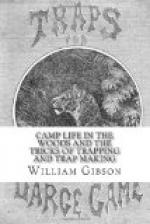To the moose hunter snow-shoes are often an absolute necessity, and trapping in many cases would be impossible without them. They are thus brought fully within the scope of our volume, and we give a few simple directions for their manufacture. Our illustration gives the correct shape of the shoe. The framework should consist of a strip of ash, hickory or some other elastic wood, bent into the form indicated and wound around the ends with twine or strips of hide. The length of the piece should be about six feet, more or less, in proportion to the size of the individual who proposes to wear the shoe. If the bending should prove difficult it may be rendered an easy matter by the application of boiling water. Across the front part two strips of stout leather, or other tough hide, are then fastened, and these further secured together by three or four bands on each side of the middle, as our drawing shows.
In the original Indian snow-shoe, from which our drawing was made, the net work was constructed from strips of moose hide, which were interlaced much after the manner of an ordinary cane-seated chair. Strips of leather, deer skin, or even split cane, above alluded to, may also be used, and the lacing may be either as our illustration represents, or in the simpler rectangular woof seen in ordinary cloth.
In order to attach the interlacing to the bow the latter should be wound with wide strips of cane, if it can be procured, or otherwise with strips of tough skin. The loops thus formed offer a continuous security, and the whole interior, with the exception of the space at the front between the cross pieces, should be neatly filled with the next work. It is well to run the first lines [Page 269] across the shoe, from side to side, passing through the windings of the bow. Across them, in the form of the letter X, the two other cords should be interlaced, after the manner shown in the cut. This forms a secure and not very complicated network, and is the style usually adopted by the Indian makers.
[Illustration]
There is another mode of attaching the lace-work to the bow which is also commonly employed, and consists in a series of holes bored at regular intervals through the wood. The winding is thus dispensed with, but the bow is sometimes weakened by the operation, and we are inclined to recommend the former method in preference. In attaching the shoe, the ball of the foot should be set on the second cross piece, and there secured by a strip of hide, which should be first adjusted as seen in the engraving, being afterward tied over the foot and then behind the ankle. Snow-shoes are made in other ways, but we believe that the typical Indian snow-shoe above described is the best.




